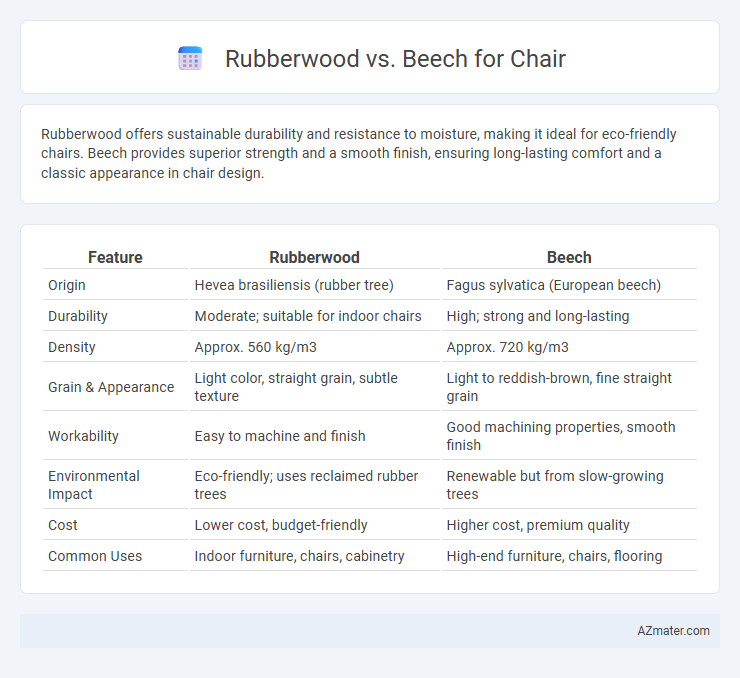Rubberwood offers sustainable durability and resistance to moisture, making it ideal for eco-friendly chairs. Beech provides superior strength and a smooth finish, ensuring long-lasting comfort and a classic appearance in chair design.
Table of Comparison
| Feature | Rubberwood | Beech |
|---|---|---|
| Origin | Hevea brasiliensis (rubber tree) | Fagus sylvatica (European beech) |
| Durability | Moderate; suitable for indoor chairs | High; strong and long-lasting |
| Density | Approx. 560 kg/m3 | Approx. 720 kg/m3 |
| Grain & Appearance | Light color, straight grain, subtle texture | Light to reddish-brown, fine straight grain |
| Workability | Easy to machine and finish | Good machining properties, smooth finish |
| Environmental Impact | Eco-friendly; uses reclaimed rubber trees | Renewable but from slow-growing trees |
| Cost | Lower cost, budget-friendly | Higher cost, premium quality |
| Common Uses | Indoor furniture, chairs, cabinetry | High-end furniture, chairs, flooring |
Rubberwood vs Beech: Overview
Rubberwood offers a sustainable, lightweight option known for its durability and resistance to warping, making it ideal for chair manufacturing. Beech wood provides a dense, hard texture with excellent shock resistance and a smooth finish preferred for high-quality, long-lasting furniture. While Rubberwood is favored for eco-friendliness and affordability, Beech excels in strength and aesthetic appeal in chair design.
Appearance and Aesthetic Differences
Rubberwood offers a light, pale yellow to creamy tone with a subtle grain pattern, providing a modern and minimalist aesthetic ideal for Scandinavian or contemporary chair designs. Beech features a slightly darker, warm pinkish hue with a tight, uniform grain that lends a classic and elegant look suitable for traditional or formal furniture styles. The contrast in color depth and grain texture makes Rubberwood chairs appear more casual and airy, while Beech chairs exude warmth and refined craftsmanship.
Durability and Strength Comparison
Rubberwood offers good durability and moderate strength, suitable for lightweight chairs with a balanced resistance to wear and tear. Beech wood exhibits superior strength and hardness, making it ideal for chairs requiring high load-bearing capacity and long-term durability. In terms of longevity, beech's dense grain structure provides enhanced resistance to dents and deformation compared to rubberwood.
Weight and Workability
Rubberwood is lighter, typically weighing around 560 kg/m3, making chairs easier to handle and transport compared to Beech, which is denser at approximately 720 kg/m3. Beech offers superior workability with its fine grain and consistent texture, allowing for smooth finishes and precise joinery, while Rubberwood's open grain may require additional sanding and treatment. The balance between Rubberwood's light weight and Beech's enhanced machining capabilities makes them suitable for different chair designs depending on ergonomic and production needs.
Environmental Impact and Sustainability
Rubberwood, sourced from the Para rubber tree after latex extraction, is highly sustainable due to its utilization of plantation timber that would otherwise be discarded, reducing deforestation pressures. Beech wood, although durable and dense, primarily comes from slower-growing European forests, raising concerns about habitat disturbance and longer regeneration cycles. Choosing rubberwood chairs supports eco-friendly practices by promoting the efficient use of renewable resources and minimizing carbon footprint compared to traditional beech wood.
Cost and Value Considerations
Rubberwood chairs generally offer a more budget-friendly option compared to beech, making them ideal for cost-conscious buyers seeking durability. Beech wood, while more expensive, provides superior strength and a finer grain that enhances long-term value and aesthetic appeal. Investing in beech can result in greater longevity and a premium finish, whereas rubberwood delivers solid performance with a lower upfront cost.
Resistance to Pests and Decay
Rubberwood demonstrates moderate resistance to pests and decay, benefiting from natural latex compounds that provide some insect repellence, but it often requires treatment to enhance durability. Beech wood has lower natural resistance to pests and decay, making it vulnerable in humid environments unless properly sealed and maintained. Both woods perform better with protective coatings, but rubberwood is typically favored for better inherent pest resistance in chair construction.
Maintenance and Longevity
Rubberwood offers high durability and requires minimal maintenance, benefiting from its natural resistance to moisture and pests, making it ideal for long-term chair use. Beechwood, although dense and strong, demands more frequent polishing and protection from excessive moisture to prevent warping or cracking, impacting its longevity if neglected. Both woods provide sturdy options, but Rubberwood's resilience and easier upkeep give it an edge for durable, low-maintenance chairs.
Suitability for Chair Design Styles
Rubberwood offers a light, neutral tone with a smooth grain, making it ideal for modern, Scandinavian, and minimalist chair designs that emphasize simplicity and natural aesthetics. Beech is denser and harder, with a fine, uniform grain, suited for traditional, classic, and mid-century modern chair styles requiring durability and an elegant finish. Both woods provide excellent workability, but Rubberwood excels in budget-friendly, eco-conscious projects, while Beech supports intricate detailing and higher-end craftsmanship.
Pros and Cons: Rubberwood vs Beech for Chairs
Rubberwood is an affordable, eco-friendly option known for its durability and resistance to warping, making it ideal for sturdy chairs, though it is softer and may dent more easily compared to beech. Beech offers superior strength, a smooth grain, and excellent shock resistance, providing a refined finish but comes at a higher cost and can be less sustainable due to slower growth. Both woods perform well in chair construction, with rubberwood favored for budget-conscious, sustainable choices while beech excels in premium, long-lasting furniture.

Infographic: Rubberwood vs Beech for Chair
 azmater.com
azmater.com